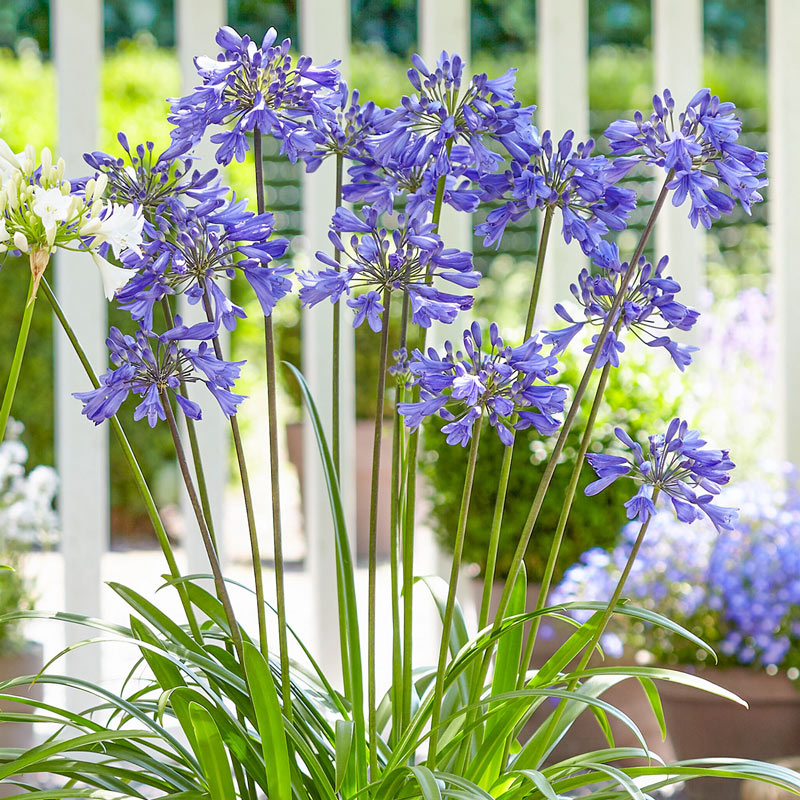Typical Agapanthus Problems and Exactly How to Resolve Them
Typical Agapanthus Problems and Exactly How to Resolve Them
Blog Article
Mastering the Art of Agapanthus Care: Important Steps for Healthy Development and Lively Blossoms
In the realm of horticulture, the growing of agapanthus stands as a fulfilling undertaking for those who look for to nurture these classy flowering plants. From selecting the best range to understanding pruning techniques, the trip in the direction of cultivating flourishing agapanthus plants is diverse and holds the vital to unlocking the complete potential of these botanical gems.

Picking the Right Agapanthus Selection

When selecting the appropriate Agapanthus variety for your yard, consider factors such as environment suitability, bloom shade, and growth practice. Agapanthus, typically referred to as Lily of the Nile or African lily, comes in a variety of colors ranging from shades of purple and blue to white. Choose a bloom shade that matches your existing garden palette to develop a harmonious landscape. Furthermore, consider the climate in your area to guarantee the Agapanthus selection you select can flourish in your specific problems. Some varieties are much more forgiving of cool temperatures, while others choose warmer climates. Comprehending the development practice of different Agapanthus ranges is essential for appropriate placement within your yard. Some ranges have a clumping growth practice, ideal for boundaries or containers, while others have a more dispersing nature, appropriate for ground cover or mass growings. By very carefully examining these factors, you can choose the excellent Agapanthus selection to boost the charm of your garden.
Perfect Growing Problems
Taking into consideration the optimum ecological requirements is essential for successful Agapanthus cultivation. Agapanthus grows in well-draining soil with a somewhat acidic to neutral pH level. When planting, select a location that receives full sunshine to partial color. In hotter climates, offering some afternoon color can avoid scorching of the fallen leaves. Agapanthus plants are delicate to chilly temperatures and must be shielded from frost during wintertime months.
To make sure healthy and balanced development and lively blossoms, plant Agapanthus bulbs at a deepness of regarding 2-4 inches and space them 8-12 inches apart. Mulching around the base of the plants helps preserve wetness and reduces weed development.
Watering and Feeding Tips
Maintaining proper moisture levels and giving crucial nutrients are crucial elements in the care regimen for Agapanthus plants. It is essential to strike an equilibrium when it comes to watering Agapanthus. These plants prefer consistently damp soil however are vulnerable to root rot if overwatered. Throughout the growing season, water deeply as soon as a week, ensuring the soil is well-draining to avoid waterlogging. In hotter climates or throughout periods of drought, more regular watering may be needed to maintain the dirt equally wet. However, lower watering in the winter months to prevent waterlogged conditions.
Fertilizing Agapanthus is crucial for promoting healthy and balanced growth and prolific blooms. Use a well balanced fertilizer, such as a 10-10-10 formula, in the early spring as brand-new development arises. Repeat this application every 6-8 weeks view publisher site throughout the expanding period. Stay clear of too much fertilization, as it can lead to rich foliage at the expense of blossoms. Constantly comply with the producer's guidelines for appropriate dilution and application approaches. By adhering to these watering and feeding suggestions, you can guarantee your Agapanthus plants thrive and produce vibrant, long-lasting blooms.
Trimming Methods for Agapanthus
Trimming Agapanthus plants at the suitable times and with correct strategies is critical for maintaining their wellness and promoting optimal development and flowering. The optimal time to prune Agapanthus is in late wintertime or very early spring before new development arises.
For flowered stems, wait till the blossoms have withered and afterwards cut them back to the base. This not only cleans up the plant's appearance however likewise urges the advancement of new blossom buds. Deadheading invested blossoms can additionally redirect the plant's power right into generating even more flowers instead of establishing seeds. Nevertheless, if you wish to collect seeds for propagation, leave some flowers to fully grown and completely dry on the plant.
Keep in mind read here to utilize tidy, sharp devices to make accurate cuts and decrease the threat of presenting illness. Agapanthus. Regular trimming will aid maintain your Agapanthus looking cool and healthy while making certain a bountiful screen of lovely blossoms
Managing Typical Parasites and Illness
After making sure proper trimming methods for Agapanthus, it is essential to address typical pests and diseases that can influence the health and vigor of these plants. One typical insect that impacts Agapanthus is the Agapanthus gall midget.
Furthermore, Agapanthus plants can suffer from origin rot if they are grown in badly draining soil. By being alert and taking timely action against pests and diseases, you can assist your Agapanthus plants thrive and produce vibrant flowers. Agapanthus.

Verdict
Finally, grasping the art of agapanthus care includes picking the ideal variety, giving excellent planting conditions, appropriate watering and feeding, suitable trimming techniques, and dealing with typical pests and diseases. By complying with these essential actions, you can ensure healthy and balanced growth and lively blooms for your agapanthus plants. Keep in mind to frequently check and preserve your plants to promote their general well-being and durability.
To ensure healthy growth and lively blossoms, plant Agapanthus light bulbs at a depth of regarding 2-4 inches and space them 8-12 inches apart. By complying with these watering and feeding ideas, you can guarantee your Agapanthus plants prosper and produce vibrant, durable blossoms.
One typical parasite that affects Agapanthus is the Agapanthus gall midge. In addition, Agapanthus plants more info here can experience from origin rot if they are planted in inadequately draining dirt. By adhering to these important actions, you can guarantee healthy and balanced development and dynamic blossoms for your agapanthus plants.
Report this page